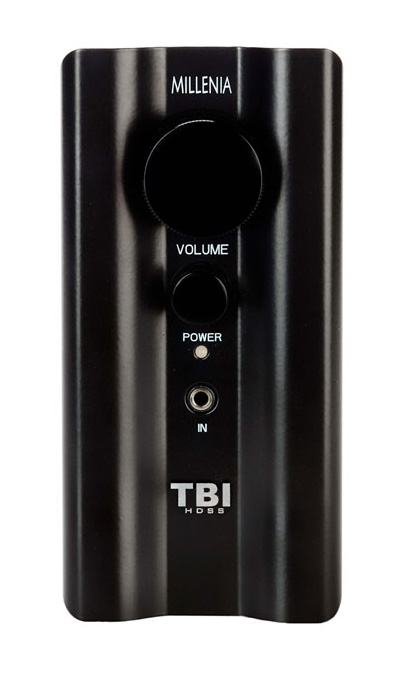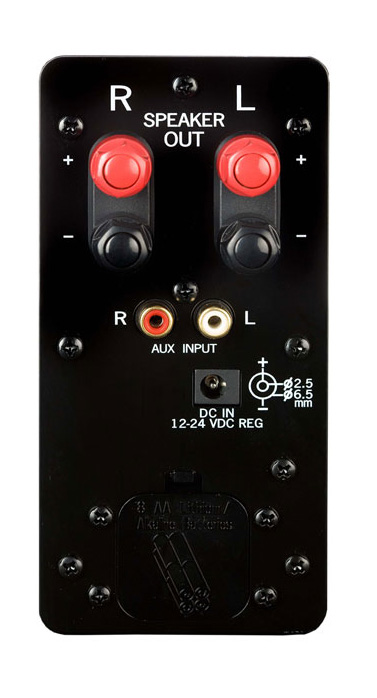|
|
You are reading the older HTML site
Positive Feedback ISSUE 62
tbi sound Millenia MG3 Integrated Amplifier as reviewed by John Hoffman
In the realm of affordable hi-fi, integrated amplifiers are traditionally known for being a viable pathway to achieve high quality sound without having to drain the household savings account. Combining the amplifier and preamplifier stages in a single chassis allows for significant cost savings, although it opens the door for potential sonic compromises. Even with the potential limitations contained in an integrated amplifier, British audio companies dominated the affordable realm of audio with their wares from the 1980's and well into the 90's. Companies such as Creek, Arcam, Audiolab, Rega, Cyrus, and Rotel set the bar for what could be accomplished in the $350 to $700 price range, and so it is not unreasonable to use their products as a yardstick for what modern components should accomplish. Many excellent audio systems were built around these classic amplifiers, and the sound quality was astonishing for the money invested. While the prices for modern integrated amplifiers may have escalated to a degree, there are still companies producing components that embody the spirit of those early British offerings. In my continual quest for great sound that is easy on the wallet, I came across an intriguing amplifier released by TBI Audio. The Millenia MG3 integrated amplifier represents an alternate implementation of a typical Class D amplifier circuit. The Millenia amplifier has a smartly finished metal chassis measuring 5.9" H by 2.75" W by 6.69" D, and a weight of two pounds. The back panel contains a pair of 5-way binding posts, a single pair of RCA input jacks, a receptacle for power input, and a battery bay that holds eight AA batteries. There is an outboard linear power supply that has an EIC connector for the power cord, and its output feeds into the rear power jack. DC power can also be fed into this point from a battery pack, and can accept up to 24 volts of input. The front panel contains the volume control, power switch and LED, and a 3.5mm input jack for alternate source devices. With a wallet friendly price tag of $500, the Millenia amplifier packs a large portion of technology into its compact enclosure. Class D amplification holds a great deal of promise, for it has elegant solutions to many of the issues with traditional Class A/B amplifier topology. A conventional Class D circuit is designed to switch the output devices on and off to amplify each ½ of the signal waveform, however it is fundamentally different than a Class A/B amplifier that also switches its output devices. In a Class D circuit the bias point is non-existent, and there is a moment where both output chips are switched off. This leads to a switching distortion, that has to be dealt with in the circuit. The methods of how to eliminate the effects of this phenomenon are closely guarded trade secrets, and is one of the main reasons that Class D amplifiers sound different from each other. The Millenia amplifier uses an unusual output stage configuration that is essentially a Class BD arrangement, which is different than the more widely used Class D topology. The output of the amplifier is generated differentially between the + and – speaker terminals, and is capable of extremely fast response times. The Class BD circuit used by TBI has quicker transition times, and therefore has fewer switching errors to deal with. Which means that only a minimal degree of filtration and correction needs to be applied to the output of the amplifier, and has negligible effects on sound quality. The preamp stage of the Millenia amplifier is not a gain stage, for its primary purpose is to provide impedance matching with the source component. Impedance mismatches between amplifier input stages and source components is an area where sound quality can be severely compromised, and the solution implemented in the TBI is an effective means to solve this issue. A newly developed Burr Brown op is used in this circuit, and has a low current and high slew rate characteristics. This allows for low distortion rates that are consistent at either high or low output levels. In essence, any non-linearities introduced by input signal swings are dealt with consistently at any volume level, which is the intended purpose of a pre-amp stage. The input voltage range of the amplifier is .1V to 4V, and can be driven by traditional audio components, or even portable music devices. Input impedance is 75K Ohms on both the RCA jacks and the 3.5mm input on the front panel.
The Millenia amplifier is capable of 32 WPC into an 8 ohm load when it's paired with the linear power supply. The same power output level can be reached if 24 volts of DC power can be supplied to the amplifier. If the TBI amplifier is driven from the internal battery pack, then it is capable of 10 WPC at less than 1% distortion. The MG3 is miserly in its use of power, and has an 85% efficiency rating when run in DC mode. Battery power is also conserved by a monitoring circuit that places the amplifier into standby mode when an input signal is not detected after a few minutes. Only 1ma per hour of current is consumed until the source is restarted, which greatly extends the longevity of the internal batteries. There is a trade off for using a chip based output device when compared to a traditional bipolar output transistor. The minimum impedance cut off for the Millenia amplifier is 3.2 ohms, so it is not a candidate for driving speakers with severe impedance curve dips. TBI recommends that the MG3 be used in DC mode if used with speakers that have a 4 ohm nominal impedance load. Fortunately modern speaker designs have relatively smooth and stable impedance characteristics, although it would be prudent to use a bit of care in selecting the proper speaker candidate for this amplifier. There are Class D amplifiers with greater power output than the Millenia amplifier. Jan Plummer at TBI Audio specifically comments on this issue in a conversation I had with him regarding the amplifier's circuit topology. While it is possible to design a Class D amplifier that supplies more power, and may have acceptable quality sound at higher levels, there are peculiarities about the circuit that does not guarantee it will perform in the same manner at lower volumes. High power from a Class D amplifier is relatively easy; as an example, most professional sound reinforcement amplifiers have adopted this technology due to its moderate cost. High output levels with low distortion, low noise floor, extended frequency response, and proper tonal balance requires a greater degree of refinement to the amplifier circuit. All of which will drive up the selling cost of an amplifier in a startling manner. Jan has worked hard to provide an affordable amplifier that makes minimal sacrifices to sound quality, and yet is robust enough to drive a wide range of speakers. The balancing act of price, flexibility, and performance is a difficult endeavor to accomplish, and TBI has clearly succeeded at this task. The Millenia amplifier possesses an inexpensive aura due to its unassuming appearance, and minimalist ergonomics. At first glance, one might mistake the TBI amplifier for one of the common inexpensive Class T amplifiers that have saturated the cheap and cheerful segment of our hobby. While there are some superficial similarities, there is certainly a great deal of sophisticated engineering that lies under the skin of the Millenia amplifier. The circuit board is populated with surface mount chips that are laid out in such a way to create the shortest circuit path possible. Along with that, the design team has taken great care to minimize the effects of RF and EMI radiation patterns in the amplifier through parts location, board layout, and internal shielding. Allocating resources to a higher quality linear power supply that is remotely located from the amplifier also contributes to the amplifier's low noise floor. Uncontrolled noise generated from both the power supply and the internal circuitry will compromise the overall sound quality of an amplifier. The result is often a component that is slightly harsh with an unnatural presentation to the midrange and treble regions. When closely examining the Millenia, it is evident that this amplifier has been painstakingly crafted to avoid many of the pitfalls and limitations associated with moderately priced gear. After removing the Millenia amplifier from its packaging, I installed it into a secondary audio system for a 200 hour break in period. I gave the amplifier a cursory listen at the beginning and performed periodic spot checks throughout its run in. Actually, after the 100 hour mark I could not detect any significant differences in sound quality, yet I continued to the 200 hour mark just to be sure the Millenia was completely broken in. I then removed an Electra Print PVA preamplifier and 300B Custom amplifier from my main system, and replaced them with the Millenia. The Sachiko Double Horn speakers are 98dB efficient and are ideal for evaluating the Millenia in both battery mode and plugged into the house mains. Source components were an Audio Magic Kukama DAC and EAD T1000 transport, or a Galibier Audio Serac turntable with Pete Riggle arm and ZYX 4D cartridge. Connections made between source components are made by ZU Audio Mission series interconnects and speaker wire. An audio Magic Mini Reference power conditioner provides clean electricity to source components, and the Millenia when run with the linear power supply. The first listening sessions with the Millenia amplifier were conducted with the linear power supply. With in excess of 30 watts per channel on demand, there is more than enough power to reach dance club sound levels out of my back loaded horn speakers. While I did not listen regularly at these kinds of volumes, the amplifier allowed the speakers to present authoritative dynamic crescendos. One important characteristic that I noticed from casual listening sessions is that the TBI amplifier has a different personality with the linear power supply in place as opposed to that of the battery system. When connected to the house mains, the character of the Millenia is smooth and relaxed, with a large and voluminous presentation of acoustic space. The first movement of the Tibet Suite is "In the Dream" by Lucia Hwong, [House of the Sleeping Beauties; Private Music 2006-2-P] which combines classical Chinese instruments and compositional style with modern electronic instruments. The opening passage begins with a majestic vocal passage by a Chinese opera performer… and her voice just floats out in front of the Sachiko speakers. A wooden flute follows the vocal passage possessing a presentation that is smooth, serene, and tranquil. A quick drum roll on a set of kettle drums then follows the quiet opening passage, and deep electronic synthesizer notes form the bass line. When compared to my 8 WPC Electra Print amplifier, the extra power provided by the Millenia amplifier adds weight and authority to this segment of the music. Normally the Sachiko speakers are used in conjunction with a sub-woofer, but this amplifier allows the Fostex drivers to delve deeper in the bass than they normally can with a small tube amplifier. With the linear power supply, the Millenia amplifier plays music with a refined and robust character that will appeal to quite a few people. While the Millenia amplifier packs a hefty wallop, this power is tempered by outstanding tone and harmonic texture. This Class D amplifier is able to blend many of the strengths found in both solid-state and tube amplifiers, and yet creates a sound that is refreshing and distinct. Integrated amplifiers that sell for $500 are not expected to excel at many things, but rather minimize its deficiencies and at least be tolerable. It appears that the designers of the Millenia did not get this memo, as this amplifier is quick and lively, yet has all the density and texture to the midrange that brings the music to life. "The Fiddling Ladies" by the Chieftains [Tears of Stone; RCA Victor 09026-68968-2] is the perfect vehicle for showcasing the strengths of this amplifier. The complex weaving of multiple violins, piano, guitar, and drum is surprisingly easy to follow since each instrument is kept in proper balance and time. Yet music is about blending many instruments to achieve a sound that is more than the sum of its parts, and that is an aspect of audio reproduction that is difficult for moderately priced gear to achieve. The TBI amplifier is a cut above for it gets the essential aspects of music right. To borrow a phrase from the British audio scene, the Millenia presents pace, rhythm, and timing in proper portions, and the music always sounds evenly balanced. Recreating the dynamic swings of music is one area where high efficiency single driver speakers are spectacular. This attribute is not about total volume, but rather how the music changes its path from loud to soft, and the speed in which it can be accomplished. Bill Basie was a master of swing, and his infusion of the emotional intensity of the blues created a musical style that in part defined our memory of the ‘Big Band'. Bill is typically referred to as Count Basie, and his music is as inspiring as anything being created today. I placed Paradise Squat on the Serac turntable, and cued up my favorite song on this album, "Blues for the Count and Oscar" [Paradise Squat; Verve VE 2 2542]. At the heart of this song is the interplay and juxtaposition between Oscar Peterson's expressive and delicate piano lines and Count Basie's brash and flamboyant organ playing. The piano ebbs and flows with a beguiling smoothness, while the organ is vibrant and flamboyant. Each instrument provides the perfect background to contrast the other against. The Millenia amplifier neatly executed the presentation of both instruments. The piano is delicate and refined with lovely tonal balance. Yet this smooth presentation shown on the piano segments does not diminish the energy of the organ to any significant extent. Basie's organ has the proper texture to its tone and displays a vibrant aura. There is an incremental, yet noticeable shift in the character of the Millenia amplifier when it is used in battery mode. For this evaluation I used an automotive jump pack for its battery and recharging capabilities. A cable had to be fabricated to fit the power port of the jump pack, but that was an easy task to accomplish. When being fed 12-volt power, the Millenia amplifier has increased micro detail, lower noise floor, and improved spatial presentation. The tonal balance of the amplifier undergoes a subtle shift, moving from a slightly warm and full character to one that is delicate and lighter in tone. In many respects the Millenia amplifier in battery mode is closer in sonics to my Electra Print 300B SET amplifier than it is any conventional solid-state piece. When revisiting the Lucia Hwong piece I found that high frequency notes had a longer decay pattern and had a greater degree of shimmer. The distinctive tone of the wood flute in the opening passage had gained a higher degree of realism. The vocal passages moved farther back in the sound stage and now floated in a space above the instruments, expressing the surrealistic feel of this composition. These gains in musical reproduction move the Millenia amplifier closer to what the Electra Print amplifier achieves, which happens to be a $4000 amp and preamp package. While the Millenia does not have the harmonic density, or the complete transparency of the SET amplifier, it comes shockingly close. Which is quite an accomplishment for a $500 integrated amplifier. The differences between linear and battery power supplies continued to be apparent with all types of music. Returning to "The Fiddling Ladies" I found that the 12-volt option increased transparency and low level detail, just as previously noted. The opening drum passage gained clarity, with each drum strike being easier to hear with the decay trailing off in a natural manner. The violins in this song are quicker and there is greater separation between each instrument. The overall sound when operated on battery power is transparent and lively, which is certainly different than the character of the Millenia when used with the linear power supply. On this song I can appreciate the differences in presentation of both power supplies, although my personal preference is for the battery option. The 3.5mm jack on the front panel allows for the connection of personal music players, cell phones, or computers. I do not use MP3 players or iPods for meaningful listening at home, but I do use them when I am out and about. Since the option is available to use a portable music player with the Millenia amplifier, it only makes sense to explore this avenue as a certain segment of readers may be interested in the results. I ripped both a WAV and a 320kps file of "Calypso" by Suzanne Vega [Solitude Standing; AM Records CD 5136] and stored them in the music files of my Motorola Droid X2. The Millenia becomes truly portable with eight AA lithium batteries installed in its battery bay. I pressed a pair of Infinity Primus 150 speakers into service for this audition, and ran this combo in various locations at my home. The sound quality of the MP3 track was adequate, although there was a discernible loss of detail to the music. Playback with the WAV file was more than acceptable, the cymbals having a dark, metallic shimmer and Vega's vocals placed out in front of the instruments. The music player program can create a distinct soundstage, pretty much on par with what one would expect from a moderately priced CD player. This listening session showed that a personal music player can be a respectable source component, and that the portable nature of the Millenia allows for alternate listening experiences that a traditional amplifier cannot provide. From an ergonomics stand point, there are two issues I would like to see resolved with the Millenia amplifier. The primary quibble I have with the amplifier is the lack of two sets or RCA jacks for inputs. Using two source components is not uncommon, and swapping RCA jacks from a CD player or phono stage is inconvenient at the very least. The second issue is not as significant, but is worth addressing. Using a subwoofer with the Millenia amplifier can only be accomplished off the speaker outputs, so it requires a set of high level inputs on the subwoofer. While theoretically there are only minor performance issues with this type of arrangement, I would still prefer to have a set of RCA jacks for subwoofer output. In terms of performance, the Millenia amplifier has a medium degree of power output, so some care must be taken to find the proper speakers for this amplifier. With 32 WPC on hand it can drive a wide range of speakers, but its performance is optimized when used with a moderately efficient speaker possessing an uncomplicated crossover network. The frequency extremes in the upper and lower registers are slightly diminished when compared to the Electra Print amplifier. Also the density and harmonic texture of the midrange area is superior on my reference amplifier. However, in context of the $500 price tag, the Millenia amplifier is a superb performer for the niche it resides in. This new generation of Class D and Class T amplification now provides an alternate pathway for hobbyists to experience quality music playback at a remarkably affordable price. With audio gear that falls into the affordable realm, there are compromises and limitations which were quite significant with the early series of Tripath based chip amps. Yet technology and innovation marches forward and each generation of amplifier continues to show improvement. A year ago I had the opportunity to review the King Rex amplifier, preamplifier, and outboard power supply. That stack became my favorite choice for building a moderately priced system around. Today that place has been taken over by the TBI Audio Millenia amplifier. The sound quality of this amplifier is excellent and actually gains another degree of refinement when used in battery mode. This neat and compact amplifier contains a surprising degree of technology and innovative engineering solutions. From the linear power supply to the impedance buffered input circuit, every aspect of this circuit exemplifies the commitment to sound quality from the design team. In the end, it is the quality of sound that matters most in this hobby. The Millenia amplifier delivers quality in spades! This amplifier is a worthy successor to the great British integrated amps of the 80's and 90's. Embedded in its chips, capacitors, and traces is that elusive quality of bringing music to life while infusing it with emotion and vitality. For those needing an affordable amplifier that is a joy to listen to, the Millenia is an amplifier you need to hear. John Hoffman
Millenia MG3 Integrated Amplifier
TBI Sound
|









